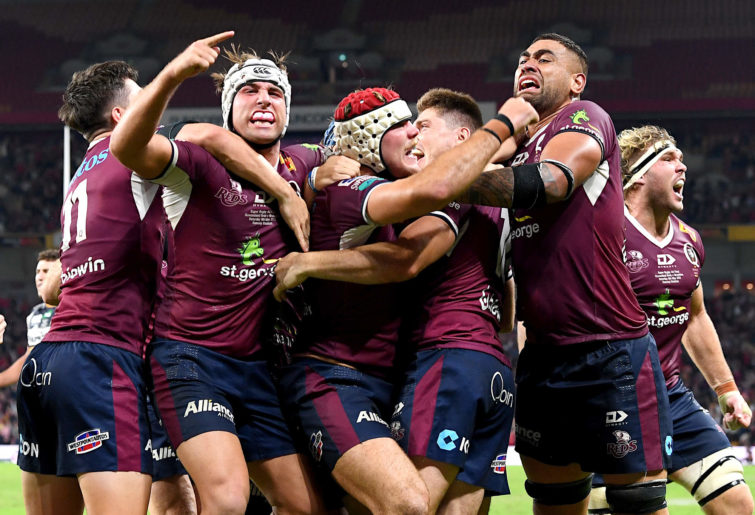While I enjoy watching international matches in the two major global football codes, namely football and rugby union, most Australians are likely to prefer watching Australian Rules and rugby league with regard to the best domestic leagues for some time yet.
Quite simply, while we all have our own preferences with regard to supporting the various football codes, both the A-League and Super Rugby cannot compare with the AFL and the NRL, which continue to dominate the major football leagues in terms of public interest and attendances, television viewing and sponsorship.
If we look at analysis of 2019 data, we see that of the NRL’s $556 million total revenue around 60 per cent came from broadcasting, with the average television audience at 459,000; 10 per cent came from game receipts; 16 per cent came from sponsorship; and 16 per cent came from wagering (revenue from poker machines in league clubs).
For the AFL, with an average television audience of then just over a million in 2018, 70 per cent of its $794 million revenue came from broadcast rights and corporate sponsors, while an estimated 14.5 per cent came from game receipts, although the AFL’s annual report does not specifically state game receipt revenue.
At a time when broadcasters continue their bidding wars for sporting events, albeit within an increasing awareness of which sports can generate profits, it is football that has suffered most, as Foxtel alone reported $180 million savings over the next three years through fewer payment obligations to sports due to the coronavirus.

(Photo by Bradley Kanaris/Getty Images)
While it was suspected early in 2020 that the AFL and NRL may lose $100 million each in 2020 in terms of revenue before both codes recovered to produce vastly smaller losses of around $22.8 million and $24.7 million respectively, it was football which suffered, most as the $57 million per season broadcasting deal to 2023 was scrapped and replaced with a one-year broadcast deal worth $32 million at best.
With Football Australia reporting in November 2020 that the 2020-21 financial year would deliver a loss of $7.3 million, much lower broadcasting revenue represents a much higher proportion of total revenue, which was predicted to decline from $106.4 million in 2019-20 to $82.7 million in 2020-21.
Football Australia is not alone. Rugby Australia in April 2021 also reported a net deficit of $27.1 million for 2020 due to the COVID-19 pandemic, with a $45.7 million reduction in revenue only offset by $31.2 million in drastic cost-cutting measures, including a $7.7 million reduction in player costs, which were down 45 per cent.
Like New Zealand Rugby, Rugby Australia is now considering selling a stake for foreign investment to prop up declining revenue.
It is clear that the AFL and NRL as primarily domestic games remain in the best position of the Australian football codes to prosper in terms of getting the best possible broadcasting deal as the two leagues attract the most fans by far in terms of attendances and television audiences.
In 2021 thus far the AFL has an average 2021 crowd of 28,600, which compares reasonably well with the 2019 average of 36,300 given some games have been played before empty stadiums in Perth alone.
The NRL has also done reasonably well, with the 2021 average to now above 13,800 compared to 16,100 in 2019.
Super Rugby crowds, with far fewer matches in the 2021 ten-round season, have fared reasonably well at 10,000 during 2021 compared to 11,000 in 2019.
However, the A-League has clearly performed worst, with 2020-21 crowds averaging around 5500 compared to the 2018-19 average of 10,864.
If one looks at the television ratings for last Saturday, 8 May 2021, it is obvious how far football has fallen behind the other codes despite 44,000 viewers watching the A-League game between the Newcastle Jets and Sydney FC on the ABC.
In contrast, Channel Seven attracted 559,000 to watch the AFL night match between Melbourne and Sydney and also had a Saturday afternoon audience of 62,000 in metropolitan Sydney, Brisbane and Adelaide despite those three cities not having a team play that afternoon.
On Foxtel the A-League audience was a dismal 5000 for Newcastle versus Sydney and 12,000 for the match between Western Sydney and Western United.

(Photo by Graham Denholm/Getty Images)
Foxtel’s NRL coverage, however, attracted 264,000 viewers to the Cowboys versus Broncos game, 228,000 to Tigers versus Titans and 179,000 for the Raiders and Knights clash.
The AFL on Foxtel attracted 757,000 viewers for its five AFL matches that day – 559,000 in metro markets and 198,000 regionally.
In the case of Super Rugby, though 207,000 watched the Reds defeat the Brumbies in the grand final on Channel Nine on 8 May 2021, its ratings for the season were more on a par with the A-League than the AFL and NRL.
While Stan has not yet released any audience numbers for its Super Rugby coverage, ratings for the weekly free-to-air match screened on 9Gem fell sharply throughout the ten-week regular season from 121,000 (five-city metropolitan market) for the 19 February game between the Reds and the Waratahs to 52,000 by Round 10.
It remains to be seen just how much broadcasting revenue each football code will attract in future years given the importance of crowd numbers and viewers, which helps broadcasters estimate the ability of any deal in terms of attracting advertising dollars.
Football Australia, while still clinging to a belief that it can become a bigger player among Australia’s football leagues, expresses optimism that a deal will emerge in the coming weeks given interest from across the globe in the A-League from many bidders driven by a thirst for content.

(Photo by Peter Mundy/Speed Media/Icon Sportswire via Getty Images)
It is perhaps this thirst for content by new players to get their foot in the door, which could include interest from Stan, Optus, Amazon Prime, DAZN, Hulu, and fuboTV, that provides the main reason the A-League may get reasonable broadcasting revenue.
And while football fans mock the lack of international interest in the AFL and NRL, it remains to be seen how prepared both domestic and international fans will be to part with their cash to watch the A-League given that football fans have so many better football leagues to choose from.
With the A-League television audience having dwindled badly in recent years, having averaged around 80,000 at its peak, it was reported in August 2019 that Optus had 700,000 Australian accounts subscribing to the Premier League.
Football is indeed the most popular sport on earth, yet I cannot see football making easy headway in the near future to reverse declining domestic crowds, although I personally would like to see the A-League succeed.
Whereas past migration patterns to Australia did help boost football crowds from the 1950s, despite its high and low years over the decades, the high reliance upon southern Europeans and Britons has now given way to mostly Chinese and Indian immigrants in recent years who may have much less affinity to watching or being involved in the football codes.
While many Australians of African backgrounds are now featuring at the highest level in the AFL and football codes and many Pacific Island immigrants most attracted to the rugby codes, it remains to be seen which football code will succeed most in terms of attracting the growing proportion of Australians with Asian backgrounds in coming years.
Thus attracting new Australians of Asian backgrounds is now an issue that confronts all football codes.
As a 2020 article highlighted, at a time when just one man and two women in the AFL had Chinese backgrounds, it was noted that Chinese Australians were among the most underrepresented ethnic groups also in terms of AFL club membership, thus requiring a concerted effort by the AFL to engage all new migrants.
Although the A-League is a league that has the potential to set up a truly national competition with location possibilities in all states and larger cities, it remains far behind the AFL and NRL with regard to attracting greater fan and corporate interest in the key cities and regions where most Australians live – namely Melbourne and Sydney and its nearby towns.
With the AFL and NRL likely to remain the most popular football leagues for some time yet, in a climate where big broadcast deals are decided mostly by the extent of interest through crowd numbers and viewing audiences, I suspect that rugby union and football are going to have some tough years ahead if recent trends are to go by.































































































